In this blog, Tannishtha Bardhan, Shraddha Mohanty and Abir Dey illustrate the use of online assessment tools and their potential use in agricultural higher education. These new technologies in the hands of great teachers can be transformational, they argue.
CONTEXT
COVID-19 induced global lockdown has affected every sphere of life and the educational sector is not an exception. The sudden shutdown of all educational organizations starting from kindergarten schools to colleges and universities has affected more than 1.2 billion children across 186 countries. This new normal situation has changed the educational sector dramatically, with the distinguishing rise of e-teaching and learning. These online teaching-learnings gained momentum due to COVID lockdown. One of the important parts of this e-teaching and learning is to evaluate the students’ performance. Hence, the present situation demands an online form of assessment of the students which was earlier being done on pen paper mode.
MODES OF ASSESSMENT
Arousing the motivation of students to achieve meaningful learning experience is a major objective of education. Often, assessments are the prime source of motivation for students and drive their decisions of when and how to study. Before discussing anything about online mode of assessment, let’s have a quick look at different modes of assessment before COVID-19. Mostly, teachers used to take traditional pen and paper mode of assessments, surprise class tests, open book examinations or practical based evaluations. One advantage of offline assessment mode is it can check misconduct on part of students. Besides, in offline mode students did not have to face technical glitches, could manage their time, could easily interact with teachers, and its familiarity in the teaching and learning community. But, offline assessment has some limitations too. Especially in OMR based tests, one has to be very cautious as answers once marked cannot be changed. Chances of missing questions occur frequently. Above all, embracing an online exam system would significantly aid in safeguarding the environment with reduced paper usage. Without a choice in the present time, adopting online teaching-learning and assessments is the only feasible option.
ONLINE ASSESSMENTS
Online assessments can be any means of evaluating student achievements, giving feedback or channelizing students forward in their learning process in a fully online mode. Assessments can be either formative, designed to monitor students’ progress in a low or no stakes environment, or summative, designed to evaluate students against criteria. Examples of such commonly used assessment tools are Google Form based quizzes, Kahoot!, Quizizz, Socrative, Near Pod, Educanon, etc.
Along with the insertion of smart technologies in the classroom, inclusion of scenarios supported by games and competition can enhance participation of students. There is a major concern that online education is one way and ensuring interaction is not as easy as regular classroom teaching. To make it more interactive and lively, quizzes, polls and games can be incorporated in the online teaching environment. Two such platforms are Kahoot and Quizizz. These tools can be easily integrated with exiting online teaching/learning platforms. The steps in using such tools are discussed in this blog.
Kahoot!:
Kahoot! is an open access, easy, game based learning platform which provides the facility to conduct gamified quizzes during online teaching-learning sessions. It can be used as an educational technology in schools and higher education institutes to assess performance of students. Teachers can use Kahoot! in two ways: either during an online class to check a student’s knowledge or it can be assigned to students at a later date where it works in a student paced manner. The most attractive part of this platform is its time bound questions, where one can allot a time duration starting from 5 seconds to 240 seconds per question in a quiz. Now let’s see how this platform works and move forward towards a step by step description of creating quizzes and its sharing with the class.
- Step 1: Open Google Chrome and type Kahoot in the search bar. You will be provided with a list of options. For teachers to sign in and create a quiz, click on https://kahoot.com and for students to join any live session on Kahoot platform click on https://kahoot.it.
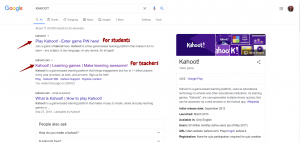
- Step 2: After opening Kahoot.com, you have to sign up if you are registering for the first time. Otherwise, you can log in with your existing id. After signing up, choose your account type (teacher, student, personal or professional) and describe your workplace (school, higher education, school administration, business).


- Step 3: The next step is choosing your plan where there is an option to choose among basic free plans and other paid versions. Our basic purpose of online assessment can be served with the basic free plan. So click on “Get Basic for Free” and continue. In the paid versions, one can choose up to 2000 participants and get all question forms and distant learning features. Institutions and organizations can go for the premium version. After this, a welcome page will pop up and it is optional to put your name or nickname there. Once done, you will be on Kahoot! Homepage.

- Step 4: On the homepage, click “Create kahoot” icon. You will be provided with different options like creating from scratch or either using any template of formative or summative assessment. Click on “New Kahoot” and start adding your questions. Since we are using the basic free version, we are allowed to use quiz type (MCQ) and true-false type questions. One can also insert videos/images and ask relevant questions regarding those. There are options to select time duration for each question and adding points to each question.
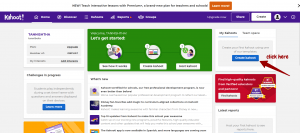
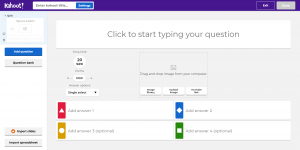
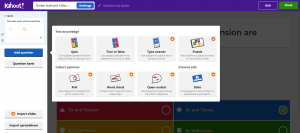
- Step 5: When the quiz is ready, you will can test it, play it and share it. It’s advisable to test the quiz prior to sharing. Sharing can also be done in the form of assignments at a later date. The best feature is one can share the quiz using the shareable link or share via google classrooms, Microsoft Teams, Twitter, Facebook etc. While assigning any kahoot quiz, there are options to choose question timer, shuffle questions and to allow students write their nicknames.
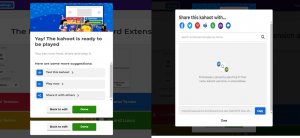
- Step 6: If a teacher wants to play the quiz right at that time, he/she can click the play button and run the quiz. Another advantage of Kahoot quiz is that it can be played both in team and individual modes.

If the teacher /instructor is playing the quiz in real time, students have to access the website using the link mentioned in step 1 and enter the pin displayed on their teacher’s screen. It is necessary for students to download the app or register. So, it saves time and reduces the technological complications for students.
After finishing a quiz, teachers can see individual and overall responses. There is also an option to see correct or incorrect answers for every question. Instructors can download the report card in a spreadsheet.

Quizizz
Quizizz is an open access website created in 2015 by Ankit Gupta and Deepak Joy Cheenath. It is used as an online assessment tool which helps teachers to create and assign quizzes to students. Along with this it also provides the feature to create lessons for students along with quiz and poll questions and with an inbuilt option of saving. It provides facility to present the quizzes live or as a home work with a specific deadline. Now let’s see how to create a quiz and share with learners using Quizizz.
- Step 1: Search for “Quizizz” in Google search bar. Click on the tab https://quizizz.com as shown below.

- Step 2: First, sign up through a valid email id. After successful signing up, you will be directed to Quizizz home page.
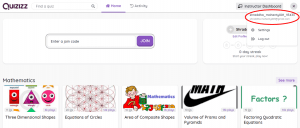
- Step 3: Apart from using inbuilt quizzes, we can create custom quizzes. For that, click on “Instructor Dashboard”. Go to “Create Quiz”. Now write the quiz title and choose relevant subjects. Click on “Next”.
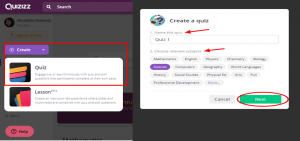
- Step 4: Choose the type of question from the given options (Multiple choice, Check box, Fill in the blank, Poll, Open ended, Slide).
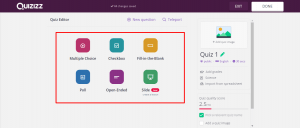
- Let’s take demonstrate its use with multiple choice questions. The following screen appears when selected. First, write the question and probable options in the boxes given. You can also add or remove options. Put a tick mark next to the correct answer.
- You can add mathematical equations by clicking the f(x) tab and click on the Media tab for adding audio or images to the question.
- A timer can be set for each question (5 seconds to 15 minutes).
- Click on “Save” icon to save the question.
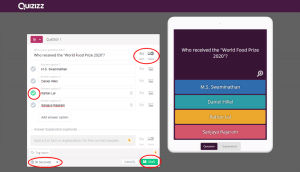
- Step 5: Click on “New question” to add more questions to the quiz. You can also use the inbuilt question bank offered by the website by clicking the “Teleport” icon. There is an “Edit” option for each question to incorporate any necessary changes.
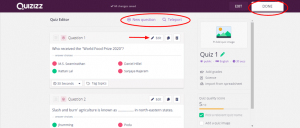
Click the “Done” tab, once you are done with your quizzes.
- Step 6: Now, fill up the quiz details like language, grade, privacy and click “Save” to proceed to the next step
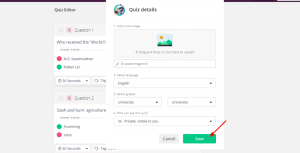
- Step 7: After creating a quiz, go to “My library”. Now, you can either “Start a live quiz” or “Assign homework”.
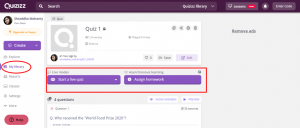
Before assigning a quiz, you need to add a class by “Import from Google Classroom” or “Create a class”.
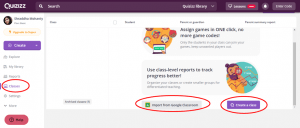
- Step 8-Click “Assign homework” and fill the required deadline and add a class. After completing the process, click the “Assign” tab.
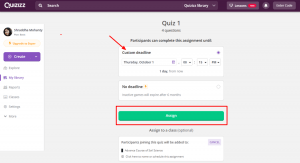
The quiz will now automatically be assigned to your class.
You can also generate a code for specific quizzes and share it with students through mail, WhatsApp, Telegram groups or through other platforms.

Students need to enter that particular code and click “Join” to access the quiz.
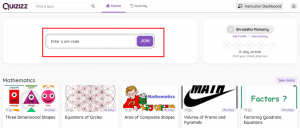
Once students turn in their assignments, you can check their scores by clicking the “Reports” tab. It also provides options viz. “Download excel”, “Rename report” and “Delete report”.

Comparison of different online assessment tools:
| Point Of Comparison | Kahoot! | Quizizz | Google Forms | MS Teams Based Quiz |
| Mode | Online | Online | Online | Online |
| Real Time Interaction | Yes | Yes | No | No |
| Instantaneous result | Yes | Yes | Yes | Yes |
| Flexibility of place | Yes | Yes | Yes | Yes |
| Practice option for students | Yes | Yes | No | No |
| Time allotted/questions | Yes | Yes | No | No |
| Competitive environment | More | More | Less | Less |
| Gamified quizzes | Yes | Yes | No | No |
| Ease of accessibility | Easy | Easy | Easy | Moderately difficult |
The above table shows comparison between Kahoot, Quizizzis and other commonly used assessment tools like MS Teams based quizzes and Google Forms. The striking difference is time allotted per question and real time interaction: which is a unique feature of Kahoot! and Quizizzis, but unavailable in Google forms and MS Teams quizzes. So, it’s not easy for students to cheat. Quizizz is student paced, students don’t have to wait for the whole class to answer a question before they continue to the next one while kahoot can be used in both teacher paced and student paced modes. Kahoot provides a feature to discuss after each question. Gamified version of assessment by Kahoot and Quizizzis help in enhancing students’ participation in an online class and keeps them motivated. Chaiyo and Nokham (2017) reported in their study that Kahoot and Quizizz has presented a lot of positives points over Google Forms in terms of enhancing concentration, engagement when used in a classroom situation. Similarly, Sabandars et al (2018) also pointed out that learners were engaged thoroughly when they were using Kahoot! in the classroom. They were also more enthusiastic and were quite satisfied as they got a chance to give exam in a live game show format. They stated that this game will be useful not only to review materials that they will present later in the classroom but will create a fun and interactive atmosphere and is easy to adopt.
ADVANTAGES OF ONLINE ASSESSMENT TOOLS:
- Online assessment tools save time and money.
- Easily accessible and easy to handle. One can use mobile phones, tablets, laptops and computers to access the quiz. Students can select their device as per convenience.
- Free availability of basic versions.
- Teachers can download the report card just after the assessment is over and can be saved for later use.
- Creates a friendly competitive environment in the online platform which motivates and engages students.
- Students can get instant results and feedback on their
- Results in effective learning by students due to involvement of more than one sense.
INTEGRATING KAHOOT! AND QUIZIZZ IN AGRICULTURAL EDUCATION SYSTEM?
Agriculture is basically a practice oriented subject where both lab as well as field based practicals are involved. So, prior to this pandemic situation, SAUs and other research institutes used to conduct both theory and practical based assessments. Although online classes help students to gain theoretical knowledge, students’ exposure to lab and field based practicals are questioned. Recorded videos and MOOCs can help students to get a practical touch to some extent but conducting practical examinations is not possible. This shortcoming can be overcome to a certain extent through Kahoot, Quizzis, MS Teams based quizzes, Google Forms etc., as these provide the facility to incorporate multimedia tools in question form and make online mode of teaching more interactive. Specifically by using Kahoot! and Quizizz, instructors can easily conduct practical examinations like identification of plant species, diseases, weeds, seeds, insects etc., with the facility of uploading images with questions in a specified time period and in an interactive manner. So, surely use of such online assessment tools will enhance the interaction in online class mode and teachers can keep a check on whether students are listening or not in an online class. Besides, teachers can use this tool for taking both formative and summative assessments of students. Instructors can use these as sub modules to evaluate what students are learning during a particular class.
DRAWBACKS OF ONLINE ASSESSMENT TOOLS
- In online mode of teaching, learning and assessment, internet connectivity is a major problem for both instructors as well as learners.
- Lack of expertise on part of instructors to handle these online tools.
- Limited number of students can be accommodated and limited facilities are available in the basic free version of these tools.
- Teachers cannot control malpractices by students.
- As students are unaware about the uses of these kinds of tools, it takes them time to get comfortable and familiar.
- Limited character length for questions.
CONCLUSION
Online assessment tools can serve as the most appropriate alternative for the pen and paper based assessments of students, especially during this COVID-19 pandemic. Although it has some disadvantages, the benefits outweigh pitfalls. These game based quizzes will not only grab students’ attention but will also motivate them. It allows instructors to conduct mobile learning i.e. they can take assessments at any place, at any time and record results immediately. In agricultural higher education, this tool can be easily incorporated to conduct assessments online during midterm or hourly examinations. These e-learning tools enable us to spread education beyond the four walls of a classroom. Some add-ons of these technologies are inculcation of positive energy among students, exploration of new concepts and ultimately adding a pinch of fun in the classroom. We guarantee that this gamification of learning has enhanced students’ engagement, including the most introverted ones, along with combining both a digital fast-paced and friendly competitive environment. So, let’s get smarter and a little bit more digitized by blending e-learning technologies with our traditional ones because technology in the hands of great teachers can be transformational.
References
Chaiyo, Y., & Nokham, R. (2017, March 1-4). The Effect of Kahoot, Quizizz and Google Forms on the Student’s Perception in the Classrooms Response System [Conference presentation]. International Conference on Digital Arts, Media and Technology, Chiang Mai, Thailand. doi:10.1109/icdamt.2017.7904957.
Kahoot!. (n.d.). In wikipedia. Retrieved October 6, 2020, from https://en.wikipedia.org/wiki/Kahoot!
Sabandar, G. N. C., Supit, N. R. & Suryana, H. T. E. (2018). Kahoot! Bring the Fun Into the Classroom. Indonesian Journal of Informatics Education, 2(2), 127-134. doi: 10.20961/ijie.v2i2.26244
 Tannishtha Bardhan, PhD Research Scholar, Department of Agricultural Communication, GBPUAT, Pantnagar – 263145 (email id: tannibckv@gmail.com)
Tannishtha Bardhan, PhD Research Scholar, Department of Agricultural Communication, GBPUAT, Pantnagar – 263145 (email id: tannibckv@gmail.com)
 Shraddha Mohanty, PhD Research Scholar, Department of Soil Science and Agricultural Chemistry, OUAT, Bhubaneswar-751 003(email id: shraddha.mohanty001@gmail.com)
Shraddha Mohanty, PhD Research Scholar, Department of Soil Science and Agricultural Chemistry, OUAT, Bhubaneswar-751 003(email id: shraddha.mohanty001@gmail.com)
 Abir Dey, Scientist, Division of Soil Science and Agricultural Chemistry, ICAR-IARI, New Delhi-110 012 (email id: abirdey21@gmail.com)
Abir Dey, Scientist, Division of Soil Science and Agricultural Chemistry, ICAR-IARI, New Delhi-110 012 (email id: abirdey21@gmail.com)





Add Comment